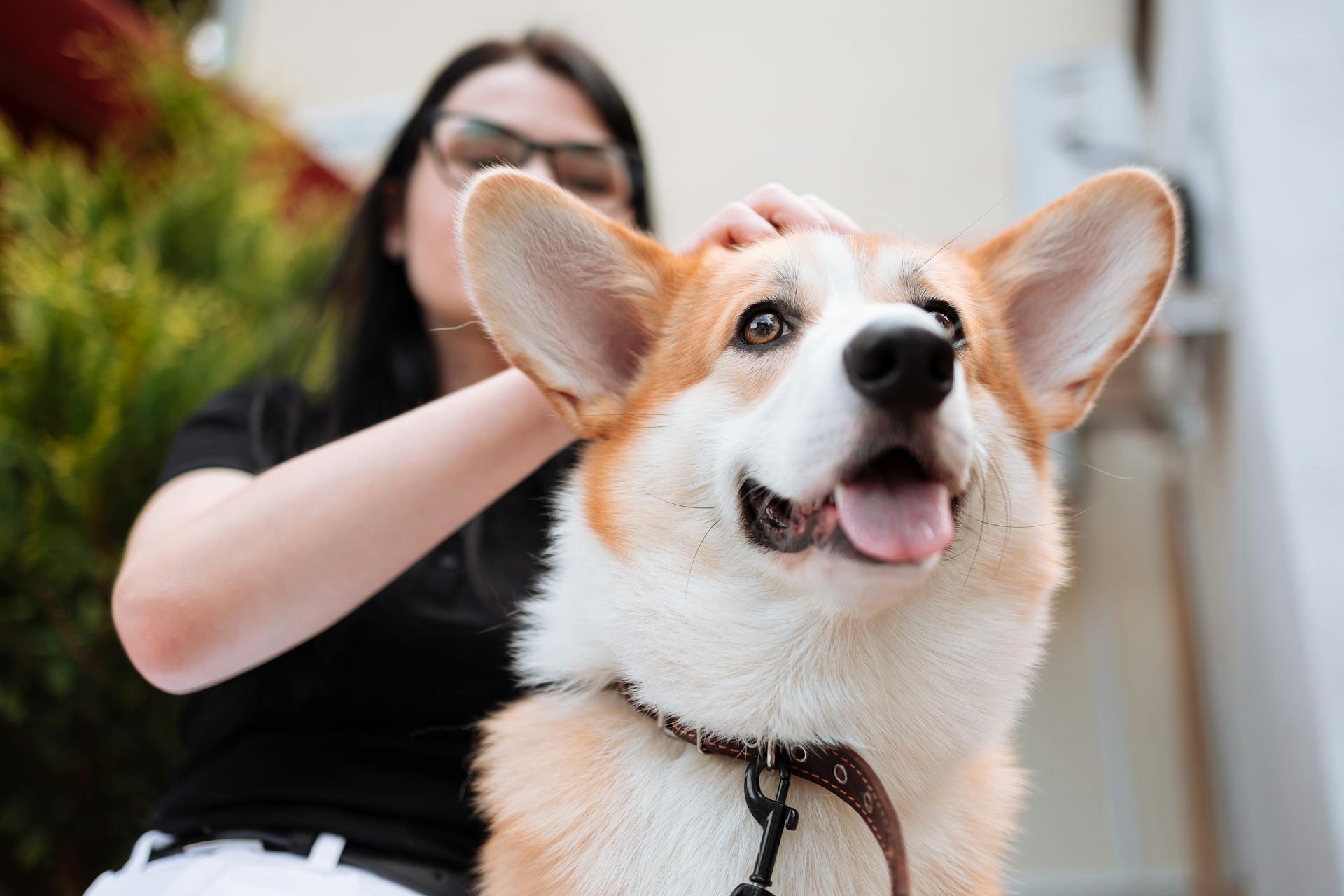
Female dogs dragging their back legs can be a worrying sight for any pet owner. This condition can be caused by a variety of factors, including hip dysplasia, arthritis, and nerve damage.
Hip dysplasia is a common cause of this issue, where the hip joint doesn't form properly, leading to pain and discomfort. In some cases, this can cause the dog to drag her back legs.
As a dog owner, it's essential to monitor your pet's behavior and watch for signs of this condition, such as limping or difficulty walking. Early detection is key to providing the necessary care and assistance.
Regular exercise and a balanced diet can help alleviate symptoms and slow down the progression of the condition. However, in severe cases, surgery may be necessary to relieve pain and improve mobility.
Worth a look: Dog Possessive of Female Owner
Causes of Back Legs Dragging
If your female dog is dragging her back legs, it's essential to identify the underlying cause as soon as possible.

Intervertebral disc disease (IVDD) is a common cause of back leg weakness in dogs, especially in adult dogs of any age, and can lead to severe back pain.
Lumbosacral stenosis is another condition that can cause a slowly progressive loss of hind leg function due to pressure on the spine from narrowing in the last spinal joint.
Fibrocartilaginous embolism is a sudden loss of hind leg function without pain, mostly in large breeds, caused by a small cartilage fragment blocking an artery.
Degenerative myelopathy is a slowly progressive loss of leg function seen especially in medium and large old dogs, and can be suspected but not always the actual cause.
Snakebite can also cause wobbly hind legs, but the signs then progress rapidly.
Other potential causes of back legs dragging in dogs include fractures and trauma, toxins and poisons, botulism, myasthenia gravis, low blood sugar, low thyroid levels, syringomyelia or Chiari-like malformation, hemivertebra, cervical spondylomyelopathy or wobbler syndrome, and neospora caninum.
Here are some of the most common causes of back legs dragging in dogs:
It's essential to see a vet as soon as possible to determine the underlying cause and get your dog the necessary treatment.
Senior Dogs and Back Legs Dragging

Senior dogs and back legs dragging can be a concerning issue for pet owners.
Arthritis is the most common cause of a gradual loss of hind-limb function in older dogs.
If your dog is unable to get up and that's a change, it warrants outreach to either their primary veterinarian or an emergency veterinarian.
Dr. Jonathan S. Block, DVM, emphasizes that it's an emergency if a dog suddenly loses function in their hind limbs and shows signs like dragging them, having trouble getting up on their own, or walking with a wobbly or uncoordinated gait.
IVDD (intervertebral disc disease) and FCE (fibrocartilaginous embolism) are common causes of sudden hind-limb collapse in senior dogs.
A dog lift harness can provide gentle support for your pet's hindquarters, taking stress off weakened legs or painful joints.
If your dog cannot bear any weight on his hind legs at all, a rear support dog wheelchair may be necessary.
Recommended read: Signs of Female Dog Going into Heat
Here are some possible reasons for back leg shaking while standing in senior dogs:
- Muscle weakness and sprains
- Joint issues, like arthritis or hip dysplasia
- Nervousness or anxiety
- Excitement or anticipation
Continuous or excessive leg shaking that doesn’t appear to be related to dreams or excitement should warrant a veterinary check to rule out potential health issues.
Treatment and Assistance
If your female dog is dragging her back legs, it's essential to take her to the vet for an evaluation to detect the underlying cause.
The severity of the hind leg condition may dictate the kind of treatment your pet receives, ranging from medication and dietary modifications to surgery.
A combination of medication, light exercise, and dietary modifications can help alleviate mild osteoarthritis, which often responds well to these remedies.
Veterinarians can treat hip dysplasia through surgery, which may include a double or triple pelvic osteotomy, a femoral head osteotomy, or a total hip replacement.
A dog lift harness can provide gentle support for your pet's hindquarters, taking stress off weakened legs or painful joints, making it ideal for pets with arthritis or dysplasia.
Readers also liked: How Long Does It Take to Spay a Female Dog
If your dog cannot bear any weight on her hind legs at all, consider getting a rear support dog wheelchair, which assumes all the weight of her rear body and does all the work that the hind legs would do.
A rear support dog wheelchair makes sense when your pet needs to avoid all weight-bearing activities, or when your pet has lost all hind leg function due to a neurological problem, or is an amputee.
See what others are reading: Sudden Weight Gain in Female Dog
Other Possible Causes
Leg shaking in dogs can be a sign of pain or discomfort, and if your female dog is dragging her back legs, it's possible that she's experiencing arthritis or hip dysplasia, both of which can cause mobility issues.
Some dogs may drag their legs due to neurological issues, such as nerve damage or a spinal condition.
In some cases, a dog may drag her legs if she's experiencing muscle weakness or paralysis, which can be caused by a range of factors including injury or disease.
For another approach, see: Dogs Drag
Injuries or Trauma

Injuries or trauma can be a significant cause of back leg shaking in dogs. Fractures or broken bones in the back leg can cause severe pain and instability, leading to shaking due to the injury and the body's attempt to protect the injured area.
Sprains occur when ligaments supporting the joints are stretched or torn, causing pain and muscle weakness, which can result in shaking in the affected leg. Dogs undergoing orthopedic surgeries, such as joint repairs or ligament reconstructions, may experience shaking in the affected leg during the recovery phase.
Trauma to the soft tissues, such as contusions, lacerations, or deep cuts, can result in pain, inflammation, and subsequent muscle spasms or shaking. Injuries that involve damage to nerves in the back leg can cause shaking or trembling.
Here are some common examples of injuries or trauma that can lead to back leg shaking:
Joint dislocations can also cause intense pain and instability, leading to shaking or trembling in the back leg. If you suspect your dog has suffered an injury or trauma, it's essential to seek veterinary attention immediately to prevent further complications.
Metabolic

Metabolic issues can be a significant contributor to hind-leg weakness in dogs. Low blood sugar, or hypoglycemia, can cause weakness and is easily diagnosed with a blood test.
Anemia, which is characterized by low red blood cells, can also lead to hind-limb weakness. This condition is also diagnosed with a blood test.
Low potassium levels, or hypokalemia, can cause muscle weakness and is another metabolic disorder that can be diagnosed with a blood test.
Finding the underlying cause of these issues is crucial for resolving them, and may require further diagnostic testing.
Readers also liked: Female Dog Passing Blood Clots in Urine
Cardiac
Cardiac causes of hind-leg weakness in dogs can be a serious concern. Heartworm disease is a common example of a cardiac condition that can lead to weakness in the hind limbs.
Adequate cardiac function is essential for blood flow and oxygen delivery to all the body's tissues. Impaired cardiac function can result in weakness, which is usually first apparent in the hind limbs.

Heart muscle disease, also known as cardiomyopathy, can also lead to hind-leg weakness. Cardiac arrhythmias, which are abnormal heart rhythms, can also be a cause.
Fluid in the sac surrounding the heart, known as pericardial effusion, can compress the heart and lead to weakness. Cardiac or pericardial tumors can also cause hind-leg weakness by compressing the heart or surrounding tissues.
Your veterinarian can diagnose cardiac causes of hind-leg weakness by performing a physical exam and running diagnostic tests.
Differences in Shaking
Shaking dog legs can be a concerning behavior, but it's not always a cause for alarm. In fact, dogs often shake their legs when they're lying down, and it's usually a normal behavior.
Dogs may shake their legs while lying down to get rid of fleas or other parasites that are irritating their skin. I've seen it happen to my own furry friends, and it's quite common.
Shaking dog legs can also occur when dogs are standing, and in this case, it may signal a more serious issue, such as arthritis or nerve damage. This is often accompanied by other signs like limping or whining.
In some cases, dogs may shake their legs due to muscle spasms or cramps, which can be painful and uncomfortable for them. I've observed dogs shaking their legs after exercising or playing strenuously.
A different take: Why Is My Female Dog Panting and Shaking
When to Seek Veterinary Help
If your dog's back legs aren't moving correctly, call your vet. This is especially true if you notice your dog is having trouble moving their back legs, which can be a sign of a serious underlying condition.
A dog's apparent collapse of their back legs can be caused by many different conditions, so it's best to err on the side of caution and seek veterinary help.
If you notice your dog dragging their back legs, it's a good idea to keep a close eye on their behavior and watch for any other signs of distress, such as pain or difficulty walking.
Suggestion: Dog Names Female Start with S
Sources
- https://www.walkervillevet.com.au/blog/ataxia-weak-back-legs-in-dogs/
- https://www.whole-dog-journal.com/health/what-causes-hind-leg-weakness-in-dogs/
- https://www.thefarmersdog.com/digest/what-to-do-if-your-senior-dogs-back-legs-are-collapsing/
- https://k9carts.com/hind-leg-weakness-in-dogs/
- https://pawsafe.com/blogs/dog-healthcare/dog-back-leg-shaking
Featured Images: pexels.com


